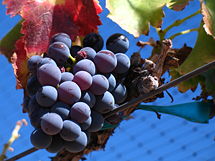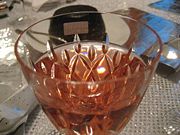Grenache
| Grenache | |
|---|---|
 |
|
| Grenache noir grapes | |
| Species: | Vitis vinifera |
| Also called: | Alicante, Cannonau, Garnacha, Grenache noir (more) |
| Origin: | Spain |
| Notable regions: | Priorat, Rhône, Sardinia, Spain |
Grenache (pronounced gren-ash) (in Spanish, Garnacha, in Catalan, Garnatxa) is probably the most widely planted variety of red wine grape in the world.[1] It ripens late, so needs hot, dry conditions such as those found in Spain and in the south of France.[2] It is generally spicy, berry-flavoured and soft on the palate with a relatively high alcohol content, but it needs careful control of yields for best results. It tends to lack acid, tannin and colour, and is usually blended with other varieties such as Syrah, Carignan and Cinsaut.
Grenache is the dominant variety in most Southern Rhône wines, especially in Châteauneuf-du-Pape where it is typically over 80% of the blend. In Australia it is typically blended in "GSM" blends with Syrah and Mourvèdre.
Grenache is also used to make rosé wines in France and Spain, notably those of the Tavel district in the Côtes du Rhône. And the high sugar levels of Grenache have led to extensive use in fortified wines, including the red vins doux naturels of Roussillon such as Banyuls, and as the basis of most Australian 'port'.
Contents |
History
Grenache may have originated in Spain, probably in Aragon or Catalonia, but has since spread over the Pyrenees into southern France and the rest of the Mediterranean.[2] It is the same grape variety as the Cannonau of Sardinia, where "[d]ried grapes, recently found in several locations, have been DNA tested and proved to be the oldest grapes in the world, dating back to 1200 BC. The Cannonau wine is made from these grapes and may therefore qualify as the mother of all the European wines" (quoted from the Sardinia page . This suggests that Grenache is really from Sardinia, and was imported to Spain when Sardinia was under Aragón rule.[2]
Clones, mutants and crosses
Like the Pinot family, Grenache comes in 'black', 'grey' and 'white' versions, plus a mutant with an altered epidermis.
The standard "black Grenache" is known as "Garnatxa Fina" in Catalan, and is the most common version.
The "hairy Grenache" is also known by names such as Lladoner Pelud (see below). The leaves look similar to Macabeo, but with fine little hairs. Recent research in Spain into this bizarre clone indicates that it produces smaller berries with a thicker skin, which suggests a greater potential than the original for making fine wine. This is an active area of investigation.
Grenache Gris is widely planted in France in particular, but is declining under the current vine pull schemes.
Grenache blanc is a major variety in its own right, particularly in France, where it is an important component of many white wines from the Rhône. It is often blended with Roussanne.
Grenache Noir was crossed with Petit Bouschet to give Alicante Bouschet, sometimes called Garnacha Tintorera. It was an important grape during Prohibition, as its thick skins survived being transported from Californian vineyards to consumers, who were allowed to make small amounts of wine at home.
In 1961, a cross between Grenache and Cabernet Sauvignon produced the French wine grape Marselan.[3]
Distribution and wines
Australia
A clone from Perpignan arrived in Australia with James Busby in 1832 collection. More significant was the introduction into South Australia of new cuttings from the South of France, by Dr Christopher Rawson Penfold in 1844. Plantings in South Australia boomed, particularly in McLaren Vale, the Barossa Valley and Clare Valley.[4] Traditionally much of the production went into a fortified wine sold as 'port', but recently interest has turned to unfortified wines either as a single varietal or in "GSM" blends with Shiraz (Syrah) and Mataro (Mourvèdre). These wines are often the product of old vines grown in excellent conditions, and can be very successful.
France

Grenache can make three very different styles of wine in France, where it is planted on nearly 100,000 hectares in the Rhône valley and across the huge vineyards of Languedoc-Roussillon, where it may be known as Alicante or Carignane Rousse. As a single varietal it makes rosé wines throughout the region, although the most famous are from the Tavel district of the Côtes du Rhône. Grenache is best known for making dry red wines, sometimes as a single varietal but more commonly blended with more chewy grapes such as Cinsault and Mourvèdre. It forms the basis of the red wines of Gigondas and Châteauneuf-du-Pape, where 12 other grapes can be included in the blend. Emmanuel Reynaud of Château Rayas in Chateauneuf du Pape, and Philippe Laurent of Domaine du Gramenon are notable proponents of Grenache as a single varietal.
Grenache is also used in vins doux naturels, sweet fortified wines from French Catalonia. Banyuls is the best known of the red vins doux naturels, but they are also made in Maury and Rivesaltes.
Italy
Grenache is known as Cannonau in Sardinia, where it may have originated and is still common.
Spain
Garnacha (Garnatxa in Catalan) used to be the most widely planted variety in its homeland of Spain, but has now been surpassed by the fast-expanding Tempranillo.[2] It is still the dominant variety in southern Aragón, particularly in the Cariñena, Calatayud and Campo de Borja appellations. In the famous Catalan wine producing region of Priorat it is traditionally blended with the dominant Carignan. In Terra Alta, just southwest of the Priorat, the blend is often the same but many wineries have been begun to blend it with Cabernet and Syrah.
USA
Grenache is grown in California's Central Valley.
Vine and viticulture
The vine is upright, with good wind tolerance and has shown to be very suited for the dry, warm windy climate around the Mediterranean.[5] Its natural vigour must be controlled for best results. The three-lobed leaves are yellowy-green, with no hairs on the undersurface unless it's the 'hairy' clone mentioned above. The medium-sized bunches are conical and winged, with blue-black berries.
In commercial production, the vine tends to alternate, with one 'good' year of production, followed by a 'lighter' year whilst it recuperates.
Synonyms
Abundante, Aleante, Aleantedi Rivalto, Aleante Poggiarelli, Alicant Blau, Alicante, Alicante Grenache, Aragones, Bois Jaune, Cannonaddu, Cannonadu Nieddu, Cannonau, Cannonau Selvaggio, Canonazo, Carignane Rosso, Elegante, Francese, Garnaccho Negro, Garnacha Comun, Garnacha Negra, Garnacha Roja, Garnacha Tinta, Garnatxa Negra, Garnatxa Pais, Gironet, Granaccia, Granaxa, Grenache Noir, Grenache Rouge, Kek Grenache, Lladoner, Mencida, Navaro, Navarra, Navarre de la Dordogne, Navarro, Negru Calvese, Ranconnat, Red Grenache, Redondal, Retagliadu Nieddu, Rivesaltes, Rousillon Tinto, Roussillon, Rouvaillard, Sans Pareil, Santa Maria de Alcantara, Tentillo, Tintella, Tintilla, Tinto Menudo, Tinto Navalcarnero, Tocai Rosso, Toledana and Uva di Spagna.[6]
Synonyms for the hairy Grenache include Garnatca Peluda, Garnatxa Pelud, Lladoner Gris, Lladoner Pelud and Lledoner Pelut.[6]
See also
- Grenache blanc
Notes and references
- ↑ Niels Lillelund: Rhône-Vinene JP Bøger - JP/Politikens Forlagshus A/S, 2004. ISBN 87-567-7140-1, pp. 25
- ↑ 2.0 2.1 2.2 2.3 Robinson, Jancis (2006). The Oxford Companion to Wine, third edition. Oxford University Press. ISBN 0-19-860990-6..
- ↑ L. Alley "New French Wine Grape Arrives in US Market" The Wine Spectator pg 17 Sept. 30, 2007
- ↑ Radden, Rosemary. "Grapes and Wines of the World". The State Library of South Australia, GPO Box 419, Adelaide SA 5001. Retrieved on 2007-05-05.
- ↑ Niels Lillelund: Rhône-Vinene JP Bøger - JP/Politikens Forlagshus A/S, 2004. ISBN 87-567-7140-1, pp. 25
- ↑ 6.0 6.1 Maul, E.; Eibach, R. (1999-06-00). "Vitis International Variety Catalogue". Information and Coordination Centre for Biological Diversity (IBV) of the Federal Agency for Agriculture and Food (BLE), Deichmanns Aue 29, 53179 Bonn, Germany. Retrieved on 2007-05-05.
Further reading
- Robinson, Jancis Vines, Grapes & Wines Mitchell Beazley 1986 ISBN 1857329996
|
|||||||||||||||||
|
|||||